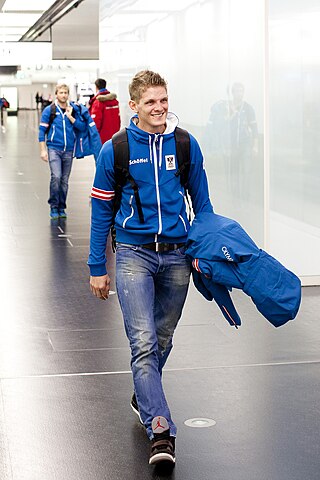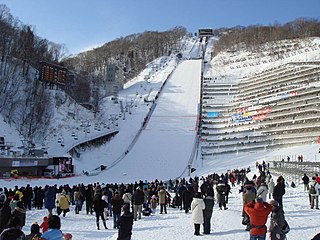Medal table
| Rank | Nation | Gold | Silver | Bronze | Total |
|---|---|---|---|---|---|
| 1 | 1 | 0 | 0 | 1 | |
| 2 | 0 | 1 | 1 | 2 | |
| Totals (2 entries) | 1 | 1 | 1 | 3 | |
Ski jumping at the 2007 Winter Universiade includes four ski jumping events. [1]
| Rank | Nation | Gold | Silver | Bronze | Total |
|---|---|---|---|---|---|
| 1 | 1 | 0 | 0 | 1 | |
| 2 | 0 | 1 | 1 | 2 | |
| Totals (2 entries) | 1 | 1 | 1 | 3 | |
| Pos. | Athlete | Dist. | Points | Jury | Total |
|---|---|---|---|---|---|
| | 92.0 | 54.0 | 51.5 | 105.5 | |
| | 71.0 | 12.0 | 47.0 | 59.0 | |
| | 68.5 | 7.0 | 46.5 | 53.5 | |
| 4. | | 67.0 | 4.0 | 43.5 | 47.5 |
| 5. | | 65.5 | 1.0 | 43.5 | 44.5 |

Skiing is the use of skis to glide on snow for basic transport, a recreational activity, or a competitive winter sport. Many types of competitive skiing events are recognized by the International Olympic Committee (IOC), and the International Ski and Snowboard Federation (FIS).

Winter sports or winter activities are competitive sports or non-competitive recreational activities which are played on snow or ice. Most are variations of skiing, ice skating and sledding. Traditionally, such games were only played in cold areas during winter, but artificial snow and artificial ice allow more flexibility. Playing areas and fields consist of either snow or ice.

Nordic combined is a winter sport in which athletes compete in cross-country skiing and ski jumping. The Nordic combined at the Winter Olympics has been held since the first Winter Olympics in 1924, while the FIS Nordic Combined World Cup has been held since 1983. Many Nordic combined competitions use the Gundersen method, where placement in the ski jumping segment results in time (dis)advantages added to the contestant's total in the cross-country skiing segment.

Ski jumping is a winter sport in which competitors aim to achieve the farthest jump after sliding down on their skis from a specially designed curved ramp. Along with jump length, competitor's aerial style and other factors also affect the final score. Ski jumping was first contested in Norway in the late 19th century, and later spread through Europe and North America in the early 20th century. Along with cross-country skiing, it constitutes the traditional group of Nordic skiing disciplines.
Freestyle skiing is a skiing discipline comprising aerials, moguls, cross, half-pipe, slopestyle and big air as part of the Winter Olympics. It can consist of a skier performing aerial flips and spins and can include skiers sliding rails and boxes on their skis. Known as "hot-dogging" in the early 1970s, it is also commonly referred to as freeskiing, jibbing, as well as many other names, around the world.
The 1972 Winter Olympics, officially the XI Olympic Winter Games and commonly known as Sapporo 1972, were a winter multi-sport event held from February 3 to 13, 1972, in Sapporo, Hokkaido Prefecture, Japan. It was the first Winter Olympic Games to take place outside Europe and North America.

Simon Ammann is a Swiss ski jumper. He is one of the most successful athletes in the history of the sport, having won four individual Winter Olympic gold medals in 2002 and 2010. His other achievements include winning the 2007 Ski Jumping World Championships, the 2010 Ski Flying World Championships, the 2010 Nordic Tournament, and the 2010 Ski Jumping World Cup overall title.

The FIS Nordic World Ski Championships is a biennial Nordic skiing event organized by the International Ski Federation (FIS). The World Championships was started in 1925 for men and opened for women's participation in 1954. World Championship events include Nordic skiing's three disciplines: cross-country skiing, ski jumping, and Nordic combined. From 1924 to 1939, the World Championships were held every year, including the Winter Olympics. After World War II, the World Championships were held every four years from 1950 to 1982. Since 1985, the World Championships have been held in odd-numbered years.

Thomas Morgenstern is an Austrian former ski jumper who competed from 2002 to 2014. He is one of the most successful ski jumpers of all time, having won the World Cup overall title twice with 23 individual wins, the Four Hills Tournament and the Nordic Tournament once each, eight World Championship gold medals, and three Winter Olympic gold medals.
The FIS Ski Flying World Championships is a ski flying event organised by the International Ski Federation (FIS) since 1972 and held every two years.

The FIS Ski Jumping World Cup is the world's highest level of ski jumping and the FIS Ski Flying World Cup as the subdivisional part of the competition. It was founded by Torbjørn Yggeseth for the 1979/80 season and organized by the International Ski Federation. Women began competing during the 2011/12 season.

Ski flying is a winter sport discipline derived from ski jumping, in which much greater distances can be achieved. It is a form of competitive individual Nordic skiing where athletes descend at high speed along a specially designed takeoff ramp using skis only; jump from the end of it with as much power as they can generate; then glide – or 'fly' – as far as possible down a steeply sloped hill; and ultimately land within a target zone in a stable manner. Points are awarded for distance and stylistic merit by five judges. Events are governed by the International Ski Federation.

Noriaki Kasai is a Japanese ski jumper. His career achievements include a gold medal at the 1992 Ski Flying World Championships, winning the 1999 Nordic Tournament, individual silver medal at the 2014 Winter Olympics, and two individual bronze medals at the 2003 Ski Jumping World Championships.

Norway competed at the 2002 Winter Olympics in Salt Lake City, United States. The nation enjoyed its best ever results in gold medals, most notably in the biathlon events, when Ole Einar Bjørndalen swept all four gold medals.

Ski jumping has been included in the program of every Winter Olympic Games. From 1924 through to 1956, the competition involved jumping from one hill whose length varied from each edition of the games to the next.
The Water Ski World Championships is a bi-annual water ski competition that has taken place since 1949. Held near the end of the competition season, the World Championships are one of the sport's oldest major championships along with the Masters Water Ski Tournament and the U.S. National Water Ski Championships.

The Große Olympiaschanze is a ski jumping hill located on the Gudiberg, south of the district of Partenkirchen of Garmisch-Partenkirchen, Bavaria, Germany, and is traditionally the venue of the Four Hills Tournament's New Year's jumping. The hill is part of a complex that also includes the K-80, K-43 and K-20 ski hills.

The Ōkurayama Ski Jump Stadium, also known as the Ōkurayama-Schanze is a ski jumping venue located in the Miyanomori area in Chūō-ku, Sapporo, Hokkaidō, Japan. Owned mostly by Sapporo City, the ski jump is on the eastern slope of the Mt. Okura. The stadium has hosted a number of winter sports events including 1972 Winter Olympics and FIS Nordic World Ski Championships 2007. The area of stadium consists of the Winter Sports Museum, the Ōkurayama Crystal House, and the Mt. Okura Observation Platform, as well as the ski jump.

Stefan Kraft is an Austrian ski jumper. He is one of the most successful ski jumpers of all time, having won the Ski Jumping World Cup and Ski Flying World Cup overall titles three times each, the Four Hills Tournament once and Raw Air Tournament three times, and three individual gold medals at the World Championships. Since March 2017, he has held the ski flying world record of 253.5 metres (832 ft).
The FIS Nordic Junior World Ski Championships is an annual nordic skiing event organized by the International Ski Federation (FIS). The Junior World Championships was started in 1977 and was first hosted in Sainte-Croix, Switzerland. The Junior World Championship events include Nordic skiing's three disciplines: cross-country skiing, ski jumping, and nordic combined.